The Western Ghats of Southwestern India, locally as the Sahyadri Hills, are formed by the Malabar Plains and the chain of mountains running parallel to India's western coast, about 30 to 50 kilometers inland. The Western Ghats intercepts the Southwestern Monsoon winds. The Western slopes of the mountains experience heavy annual rainfall (with 80 percent of it falling during the southwest monsoon from June to September), while the Eastern slopes are drier; rainfall also decreases from South to North. Dozens of rivers originate in these mountains, including the peninsula’s three major eastward-flowing rivers. The wide variation of rainfall patterns in the Western Ghats, coupled with the region’s complex geography, produces a great variety of vegetation types. These include scrub forests in the low-lying rain shadow areas and the plains, deciduous and tropical rainforests up to about 1,500 meters, and a unique mosaic of cloud forests and rolling grasslands above 1,500 meters. It is no wonder then that the changing eco-tones and the vast variety of eco-systems are home to numerous endemic species of birds, mammals & vegetation.
This 8 day journey is an intense birding trip with little time for sightseeing. The tour covers the lowland forests at Thattekkad, the famed Periyar Tiger Reserve, the shola-grasslands of Munnar & Ooty and the dry deciduous forests at Mudumalai.
Day 1, 2 , 3 – Thattekkad
Thattekkad is a lowland forest with several types of eco-systems – river¬ine, grasslands, evergreen, scrub, dry deciduous, lowland forest, enabling it to be one of the best birding destinations in India. This is also home to most of the endemics of the Western Ghats. One should sight the Whitebel¬lied Treepie, Rufous Babbler, Crimsonbacked Sunbird, White Bellied Blue Flycatcher, Wayanad Laughing Thrush, Malabar Parakeet, Malabar Grey Hornbill besides owls like the Mottled Wood Owl, Oriental Bay Owl, Orien¬tal scopes owl, Brown Fish Owl, Oriental Scopes Owl and Spotbellied Eagle Owl. You should also be able to sight the Red Spurfowl, Grey Jungle Fowl, Indian Pitta, Black-throated Munia and the Grey headed fishing eagle.
Day 4 – Periyar
Periyar Tiger Reserve is one of the finest wildlife & birding destinations in South India. With over 320 bird species identified and a leading habitat for the Bengal Tiger, this sanctuary is an ideal destination of the tour. Periyar National Park contains a variety of habitats from grassland and dry decidu¬ous forest to evergreen forest and riverside scrub. As a result of its wide range of habitats Periyar boasts an impressive list of resident species includ¬ing about half the peninsular endemics and near-endemics We will spend the day searching here for some very special species including the very secre¬tive and wary Wynaad Laughingthrush. Other birds to look out for include White-rumped and Brown-backed Needletails, Oriental Honey-Buzzard, Black Eagle, the striking Black Baza, Pompadour Green and Mountain Imperial Pi¬geon, the migratory Chestnut-winged Cuckoo, Yellow-browed Bulbul, Gray-breasted Prinia, Thick-billed Warbler, Brown-cheeked Fulvetta, and the Asian Fairy Bluebird among other more widespread species. We may also sight the Woolly-necked Stork, Besra, Vernal Hanging Parrot, Jungle Owlet, White-rumped Spinetail, Black-naped Monarch and the Little Spiderhunter.
Day 5, 6 – Munnar.
We will leave for Munnar via the Ghats to Khambam where we should sight the Large Grey Babbler, Common Babbler, Jungle Bush Quail and the Grey Fanco¬lin. We will proceed to Bodi Ghats en-route Munnar and stop over for sighting the rare Yellow Throated Bulbul, Indian Robin, Sirkeer Malkoha, Short Toed Snake Eagle, Bluefaced Malkoha and the Black eagle. We will reach Munnar by evening. The next day we will go birding in the sholas (high altitude montane forests) and grasslands for the Nilgiri Pipit, Painted Bush Quail, Nilgiri Wood Pigeon, Black & Orange Flycatcher, Nilgiri Flycatcher, Whitebellied Shortwing, Broadtailed Grassbird, Grasshopper Warbler.
Day 7 – Ooty.
We will start early in the morning birding at Chinnar (dry scrub forest) looking for White-bellied Drongo, Blue faced Malkoha, White-naped woodpecker, Blue-beared bee-eater, Sirkeer Malkoha, Jungle Bush Quail and the Yellow-legged Button quail. From here taking the long drive, we will reach Ooty by evening. Ooty - a hill station, at about 2,200m in the Nilgiri Hills - is where we will look for the endemic Nilgiri Laughing Thrush, White-bellied Shortwing, and Black-and-rufous, Rusty-tailed and Nilgiri Flycatchers.
Day 8 – Drop to Kochi.
After morning birding at birding at Ooty and surrounding areas, we will make our way to Kochi by noon.
Departures
Inclusions
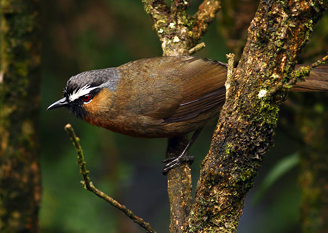
Nilgiri Laughing Thrush @ Aditya Roy
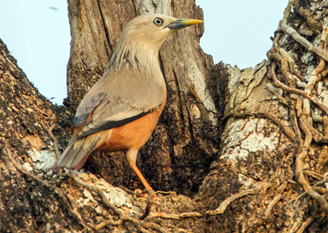
Malabar White-headed Starling @ Mike Barth
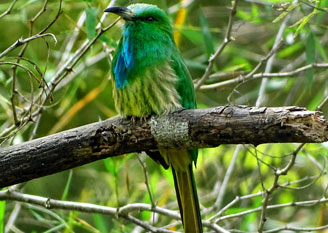
Blue-bearded Bee-eater @ Anup Jacob
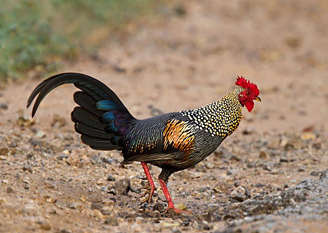
Grey Jungle Fowl at Thattekkad @ Daniel Mauras
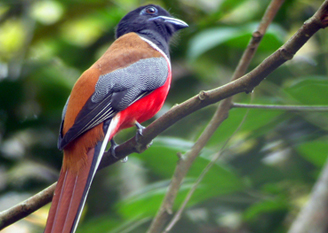
Malabar Trogon at Thattekkad @ Keith Wiggers
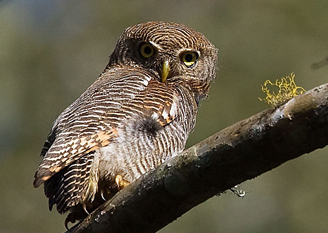
Jungle Owlet at Periyar Tiger Reserve @ Daniel Mauras
We Accept ![]()
![]()
| © Copyright 2018 - Kalypso Adventures Pvt Ltd | Designed by Tedsys |